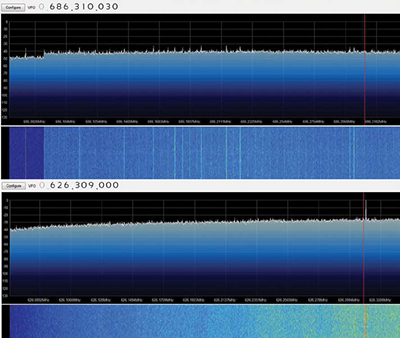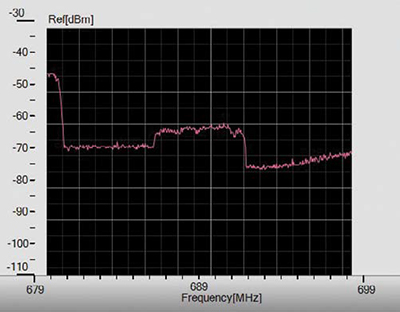
Doug Lung
Over the years I’ve assembled a kit of small devices, most the size of a USB thumb drive, that I carry around the country with me to troubleshoot problems and explore the RF spectrum. This month I’ll describe the kit and how I used it to check out COFDM transmission at last month’s International CES.

Fig. 1: SDR# CES SDR Display
Monitoring over-the-air TV signals requires a receiver, and the best USB ATSC receiver I’ve found is the Hauppauge Aero-M. It uses a Maxlinear MXF-111 tuner with an LGDT3305 ATSC demodulator and LG2161 ATSC-MH demodulator. It is the most sensitive, interference-resistant tuner I’ve found, works with both Linux and Windows and can be purchased directly from Hauppauge for $69. The folks at KernelLabs.com have come up with a way to use the tuner for DVB-T as well as ATSC, but I haven’t tested that.
SWISS ARMY SDR
A software-defined radio can be useful for tracking down interference and during downtime can serve as an FM radio receiver. I’ve tested several of the RTL2832U DVB-T/DAB tuners and the one that worked the best for me is the Newsky TV28T. The tuner chip, a Rafael Micro R820T, covers 24–1850 MHz and uses the Realtek RTL2832U demodulator chip, which can output a 2.4 MHz wide I&Q signal over USB for use with many SDR programs.
The wide range of SDR applications makes it possible to receive just about any signal (analog or digital) that will fit within the RTL2832U’s 2.4 MHz bandwidth. It is amazing! I can use one small, cheap device to demodulate a CW beacon on the 2-meter ham band, catch NOAA weather broadcasts in the 162 MHz band, check out the 450/455 MHz BAS band, monitor 950 MHz FM STLs, listen to an FM radio station, and track aircraft using their 1090 MHz ADS-B signals! When combined with the right software (more on that later) it can also be used to analyze signals. The device performs well in the function it was originally sold for, receiving DVB-T. While visiting the Rohde and Schwarz plant in Teisnach I hooked up a small vertical whip to the TV28T and was able to pick up and decode one of the DVB-T multiplexes available in Bavaria. I didn’t test its DAB capability.

Miniature RF toolkit
The professional video industry's #1 source for news, trends and product and tech information. Sign up below.
The Newsky TV28T is available direct from China for under $20, including shipping. I’ve found differences in the performance of these tuners so you may want to order two or three and pick the best one. A unit I ordered from China turned out to be much more sensitive than a unit that looked exactly the same with the same specs at a slightly higher price purchased from Amazon in the U.S.
Between the TV28T and Aero-M you’ll be able to identify and receive almost anything except AM, although there are up-converters available that will allow MW and HF reception on the TV28T. One problem is that the TV28T can’t receive more than a 2.4 MHz slice of spectrum at a time and the Aero-M is limited to receiving TV channels.
I’ve found the Triarchy TSA5G35 USB spectrum analyzer helpful in identifying signals for more detailed analysis with the TV28T. At $599, it isn’t cheap, but I’ve found it worthwhile even with its limited measurement capability. The extended frequency range, from 1 MHz to 5.35 GHz, makes it useful for checking 2 GHz BAS links and tweaking antennas. Since I wrote about the TSA5G35 last July, Triarchy has introduced a $529 analyzer, the TSA4G1 covering 1–4150 MHz, the $629 TSA6G1, covering 1–6150 MHz, and a microwave-only unit, the $999 TSA12G5 covering 4.9–11.1 GHz and 11.1–12.5 GHz.
ADAPTERS, ANTENNAS AND SOFTWARE
In addition to these USB devices, you’ll want some adapters. The Aero-M and TV28T both require MCX-type connectors. The Aero-M comes with an F-adapter that will also work with the TV28T. The TSA5G35 has an SMA input, so I’d recommend getting a short BNC female to SMA male cable. An assortment of adapters to other common RF fittings and a few attenuators will come in handy.
For antennas, you can use one of the antennas that comes with the Aero-M or TV28T for less demanding applications and add the Mohu Leaf Ultimate with its built-in USB powered preamp for more reliable TV reception. It isn’t much larger than a sheet of paper and is thin enough slip inside most computer bags.

Fig. 2: Channel 50 CES Spectrum Display
Once you’ve assembled the hardware, you’ll need software to make full use of it. While the Aero-M comes with WinTV software, it isn’t very useful for troubleshooting and even lacks a program guide. A much better solution is TSReader, which will show all of the PSIP data, count errors, measure bit rates (average and real- time) and even record the full multiplex for analysis later. When tracking down a problem with PSIP, having the ability to record the multiplex and upload it for remote analysis is handy. Visit www.tsreader.com/legacy for details on features and pricing. You may also want to consider an ASI-to-USB adapter for use with TSReader.
I carry an Alitronika AsiPOD. The company also has a range of USB controlled RF test gear for ATSC and DVB. The TV28T SDR software is free and the simplest option for Windows is SDR#. It has enough flexibility to be used as a spectrum/ signal analyzer as well as receiver. Fig. 1, a screen capture from SDR#, shows the difference between the Ch. 50 COFDM signal (top) and Ch. 40 ATSC (bottom) signal I grabbed at International CES. Some of the visible differences are the channel edge roll off, lack of a pilot carrier approximately 310 kHz up from the band edge on the COFDM signal and lines showing the carriers in the OFDM signal. Note that the lines in the spectrum display are a sampling alias, not the individual 27,841 actual carriers. SDR# will work on Linux, but you can use GNURadio to build your own SDR with signals from the TV28T. Another option for Linux is the gqrx SDR.
Fig. 2 shows the Ch. 50 spectrum display from my Triarchy TSA5G35, using the software provided with the unit.
I’d be interested in what RF tools you have in your carryon or laptop bag. Email me atdlung@transmitter.com.

Doug Lung is one of America's foremost authorities on broadcast RF technology. As vice president of Broadcast Technology for NBCUniversal Local, H. Douglas Lung leads NBC and Telemundo-owned stations’ RF and transmission affairs, including microwave, radars, satellite uplinks, and FCC technical filings. Beginning his career in 1976 at KSCI in Los Angeles, Lung has nearly 50 years of experience in broadcast television engineering. Beginning in 1985, he led the engineering department for what was to become the Telemundo network and station group, assisting in the design, construction and installation of the company’s broadcast and cable facilities. Other projects include work on the launch of Hawaii’s first UHF TV station, the rollout and testing of the ATSC mobile-handheld standard, and software development related to the incentive auction TV spectrum repack. A longtime columnist for TV Technology, Doug is also a regular contributor to IEEE Broadcast Technology. He is the recipient of the 2023 NAB Television Engineering Award. He also received a Tech Leadership Award from TV Tech publisher Future plc in 2021 and is a member of the IEEE Broadcast Technology Society and the Society of Broadcast Engineers.
